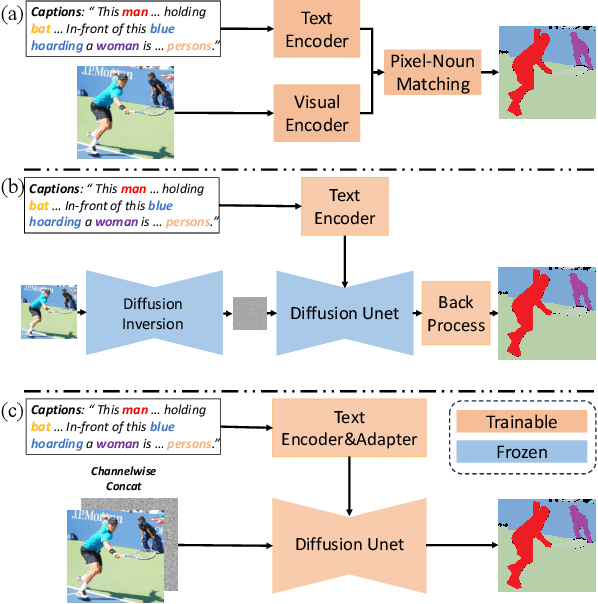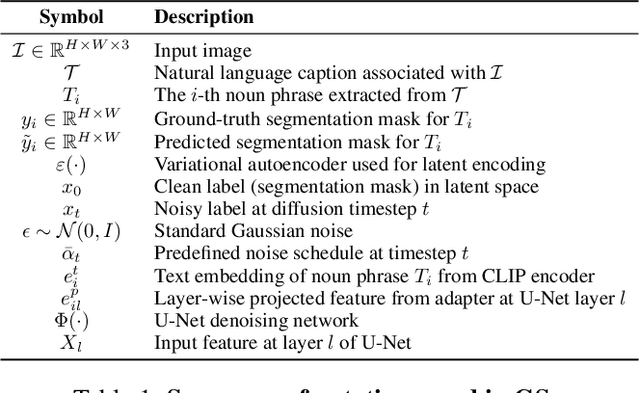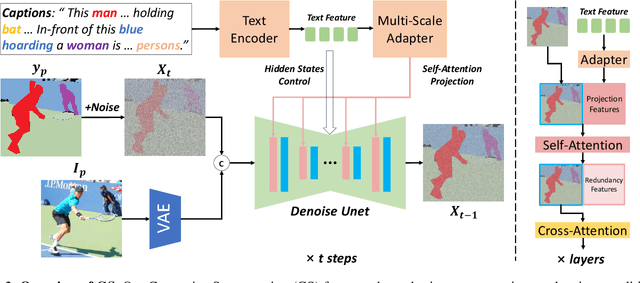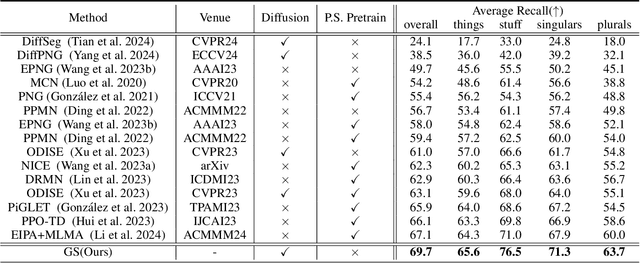Liang Lin
Robust Egocentric Referring Video Object Segmentation via Dual-Modal Causal Intervention
Dec 30, 2025Abstract:Egocentric Referring Video Object Segmentation (Ego-RVOS) aims to segment the specific object actively involved in a human action, as described by a language query, within first-person videos. This task is critical for understanding egocentric human behavior. However, achieving such segmentation robustly is challenging due to ambiguities inherent in egocentric videos and biases present in training data. Consequently, existing methods often struggle, learning spurious correlations from skewed object-action pairings in datasets and fundamental visual confounding factors of the egocentric perspective, such as rapid motion and frequent occlusions. To address these limitations, we introduce Causal Ego-REferring Segmentation (CERES), a plug-in causal framework that adapts strong, pre-trained RVOS backbones to the egocentric domain. CERES implements dual-modal causal intervention: applying backdoor adjustment principles to counteract language representation biases learned from dataset statistics, and leveraging front-door adjustment concepts to address visual confounding by intelligently integrating semantic visual features with geometric depth information guided by causal principles, creating representations more robust to egocentric distortions. Extensive experiments demonstrate that CERES achieves state-of-the-art performance on Ego-RVOS benchmarks, highlighting the potential of applying causal reasoning to build more reliable models for broader egocentric video understanding.
ACD: Direct Conditional Control for Video Diffusion Models via Attention Supervision
Dec 24, 2025Abstract:Controllability is a fundamental requirement in video synthesis, where accurate alignment with conditioning signals is essential. Existing classifier-free guidance methods typically achieve conditioning indirectly by modeling the joint distribution of data and conditions, which often results in limited controllability over the specified conditions. Classifier-based guidance enforces conditions through an external classifier, but the model may exploit this mechanism to raise the classifier score without genuinely satisfying the intended condition, resulting in adversarial artifacts and limited effective controllability. In this paper, we propose Attention-Conditional Diffusion (ACD), a novel framework for direct conditional control in video diffusion models via attention supervision. By aligning the model's attention maps with external control signals, ACD achieves better controllability. To support this, we introduce a sparse 3D-aware object layout as an efficient conditioning signal, along with a dedicated Layout ControlNet and an automated annotation pipeline for scalable layout integration. Extensive experiments on benchmark video generation datasets demonstrate that ACD delivers superior alignment with conditioning inputs while preserving temporal coherence and visual fidelity, establishing an effective paradigm for conditional video synthesis.
Massive Editing for Large Language Models Based on Dynamic Weight Generation
Dec 17, 2025Abstract:Knowledge Editing (KE) is a field that studies how to modify some knowledge in Large Language Models (LLMs) at a low cost (compared to pre-training). Currently, performing large-scale edits on LLMs while ensuring the Reliability, Generality, and Locality metrics of the edits remain a challenge. This paper proposes a Massive editing approach for LLMs based on dynamic weight Generation (MeG). Our MeG involves attaching a dynamic weight neuron to specific layers of the LLMs and using a diffusion model to conditionally generate the weights of this neuron based on the input query required for the knowledge. This allows the use of adding a single dynamic weight neuron to achieve the goal of large-scale knowledge editing. Experiments show that our MeG can significantly improve the performance of large-scale KE in terms of Reliability, Generality, and Locality metrics compared to existing knowledge editing methods, particularly with a high percentage point increase in the absolute value index for the Locality metric, demonstrating the advantages of our proposed method.
Enhancing Visual Programming for Visual Reasoning via Probabilistic Graphs
Dec 16, 2025Abstract:Recently, Visual Programming (VP) based on large language models (LLMs) has rapidly developed and demonstrated significant potential in complex Visual Reasoning (VR) tasks. Previous works to enhance VP have primarily focused on improving the quality of LLM-generated visual programs. However, they have neglected to optimize the VP-invoked pre-trained models, which serve as modules for the visual sub-tasks decomposed from the targeted tasks by VP. The difficulty is that there are only final labels of targeted VR tasks rather than labels of sub-tasks. Besides, the non-differentiable nature of VP impedes the direct use of efficient gradient-based optimization methods to leverage final labels for end-to-end learning of the entire VP framework. To overcome these issues, we propose EVPG, a method to Enhance Visual Programming for visual reasoning via Probabilistic Graphs. Specifically, we creatively build a directed probabilistic graph according to the variable dependency relationships during the VP executing process, which reconstructs the non-differentiable VP executing process into a differentiable exact probability inference process on this directed probabilistic graph. As a result, this enables the VP framework to utilize the final labels for efficient, gradient-based optimization in end-to-end supervised learning on targeted VR tasks. Extensive and comprehensive experiments demonstrate the effectiveness and advantages of our EVPG, showing significant performance improvements for VP on three classical complex VR tasks: GQA, NLVRv2, and Open Images.
MM-CoT:A Benchmark for Probing Visual Chain-of-Thought Reasoning in Multimodal Models
Dec 09, 2025Abstract:The ability to perform Chain-of-Thought (CoT) reasoning marks a major milestone for multimodal models (MMs), enabling them to solve complex visual reasoning problems. Yet a critical question remains: is such reasoning genuinely grounded in visual evidence and logically coherent? Existing benchmarks emphasize generation but neglect verification, i.e., the capacity to assess whether a reasoning chain is both visually consistent and logically valid. To fill this gap, we introduce MM-CoT, a diagnostic benchmark specifically designed to probe the visual grounding and logical coherence of CoT reasoning in MMs. Instead of generating free-form explanations, models must select the sole event chain that satisfies two orthogonal constraints: (i) visual consistency, ensuring all steps are anchored in observable evidence, and (ii) logical coherence, ensuring causal and commonsense validity. Adversarial distractors are engineered to violate one of these constraints, exposing distinct reasoning failures. We evaluate leading vision-language models on MM-CoT and find that even the most advanced systems struggle, revealing a sharp discrepancy between generative fluency and true reasoning fidelity. MM-CoT shows low correlation with existing benchmarks, confirming that it measures a unique combination of visual grounding and logical reasoning. This benchmark provides a foundation for developing future models that reason not just plausibly, but faithfully and coherently within the visual world.
GraspView: Active Perception Scoring and Best-View Optimization for Robotic Grasping in Cluttered Environments
Nov 06, 2025Abstract:Robotic grasping is a fundamental capability for autonomous manipulation, yet remains highly challenging in cluttered environments where occlusion, poor perception quality, and inconsistent 3D reconstructions often lead to unstable or failed grasps. Conventional pipelines have widely relied on RGB-D cameras to provide geometric information, which fail on transparent or glossy objects and degrade at close range. We present GraspView, an RGB-only robotic grasping pipeline that achieves accurate manipulation in cluttered environments without depth sensors. Our framework integrates three key components: (i) global perception scene reconstruction, which provides locally consistent, up-to-scale geometry from a single RGB view and fuses multi-view projections into a coherent global 3D scene; (ii) a render-and-score active perception strategy, which dynamically selects next-best-views to reveal occluded regions; and (iii) an online metric alignment module that calibrates VGGT predictions against robot kinematics to ensure physical scale consistency. Building on these tailor-designed modules, GraspView performs best-view global grasping, fusing multi-view reconstructions and leveraging GraspNet for robust execution. Experiments on diverse tabletop objects demonstrate that GraspView significantly outperforms both RGB-D and single-view RGB baselines, especially under heavy occlusion, near-field sensing, and with transparent objects. These results highlight GraspView as a practical and versatile alternative to RGB-D pipelines, enabling reliable grasping in unstructured real-world environments.
SaFeR-VLM: Toward Safety-aware Fine-grained Reasoning in Multimodal Models
Oct 08, 2025Abstract:Multimodal Large Reasoning Models (MLRMs) demonstrate impressive cross-modal reasoning but often amplify safety risks under adversarial or unsafe prompts, a phenomenon we call the \textit{Reasoning Tax}. Existing defenses mainly act at the output level and do not constrain the reasoning process, leaving models exposed to implicit risks. In this paper, we propose SaFeR-VLM, a safety-aligned reinforcement learning framework that embeds safety directly into multimodal reasoning. The framework integrates four components: (I) QI-Safe-10K, a curated dataset emphasizing safety-critical and reasoning-sensitive cases; (II) safety-aware rollout, where unsafe generations undergo reflection and correction instead of being discarded; (III) structured reward modeling with multi-dimensional weighted criteria and explicit penalties for hallucinations and contradictions; and (IV) GRPO optimization, which reinforces both safe and corrected trajectories. This unified design shifts safety from a passive safeguard to an active driver of reasoning, enabling scalable and generalizable safety-aware reasoning. SaFeR-VLM further demonstrates robustness against both explicit and implicit risks, supporting dynamic and interpretable safety decisions beyond surface-level filtering. SaFeR-VLM-3B achieves average performance $70.13$ and $78.97$ on safety and helpfulness across six benchmarks, surpassing both same-scale and $>10\times$ larger models such as Skywork-R1V3-38B, Qwen2.5VL-72B, and GLM4.5V-106B. Remarkably, SaFeR-VLM-7B benefits from its increased scale to surpass GPT-5-mini and Gemini-2.5-Flash by \num{6.47} and \num{16.76} points respectively on safety metrics, achieving this improvement without any degradation in helpfulness performance. Our codes are available at https://github.com/HarveyYi/SaFeR-VLM.
Embodied Arena: A Comprehensive, Unified, and Evolving Evaluation Platform for Embodied AI
Sep 18, 2025Abstract:Embodied AI development significantly lags behind large foundation models due to three critical challenges: (1) lack of systematic understanding of core capabilities needed for Embodied AI, making research lack clear objectives; (2) absence of unified and standardized evaluation systems, rendering cross-benchmark evaluation infeasible; and (3) underdeveloped automated and scalable acquisition methods for embodied data, creating critical bottlenecks for model scaling. To address these obstacles, we present Embodied Arena, a comprehensive, unified, and evolving evaluation platform for Embodied AI. Our platform establishes a systematic embodied capability taxonomy spanning three levels (perception, reasoning, task execution), seven core capabilities, and 25 fine-grained dimensions, enabling unified evaluation with systematic research objectives. We introduce a standardized evaluation system built upon unified infrastructure supporting flexible integration of 22 diverse benchmarks across three domains (2D/3D Embodied Q&A, Navigation, Task Planning) and 30+ advanced models from 20+ worldwide institutes. Additionally, we develop a novel LLM-driven automated generation pipeline ensuring scalable embodied evaluation data with continuous evolution for diversity and comprehensiveness. Embodied Arena publishes three real-time leaderboards (Embodied Q&A, Navigation, Task Planning) with dual perspectives (benchmark view and capability view), providing comprehensive overviews of advanced model capabilities. Especially, we present nine findings summarized from the evaluation results on the leaderboards of Embodied Arena. This helps to establish clear research veins and pinpoint critical research problems, thereby driving forward progress in the field of Embodied AI.
Thinking Before You Speak: A Proactive Test-time Scaling Approach
Aug 27, 2025Abstract:Large Language Models (LLMs) often exhibit deficiencies with complex reasoning tasks, such as maths, which we attribute to the discrepancy between human reasoning patterns and those presented in the LLMs' training data. When dealing with complex problems, humans tend to think carefully before expressing solutions. However, they often do not articulate their inner thoughts, including their intentions and chosen methodologies. Consequently, critical insights essential for bridging reasoning steps may be absent in training data collected from human sources. To bridge this gap, we proposes inserting \emph{insight}s between consecutive reasoning steps, which review the status and initiate the next reasoning steps. Unlike prior prompting strategies that rely on a single or a workflow of static prompts to facilitate reasoning, \emph{insight}s are \emph{proactively} generated to guide reasoning processes. We implement our idea as a reasoning framework, named \emph{Thinking Before You Speak} (TBYS), and design a pipeline for automatically collecting and filtering in-context examples for the generation of \emph{insight}s, which alleviates human labeling efforts and fine-tuning overheads. Experiments on challenging mathematical datasets verify the effectiveness of TBYS. Project website: https://gitee.com/jswrt/TBYS
GS: Generative Segmentation via Label Diffusion
Aug 27, 2025



Abstract:Language-driven image segmentation is a fundamental task in vision-language understanding, requiring models to segment regions of an image corresponding to natural language expressions. Traditional methods approach this as a discriminative problem, assigning each pixel to foreground or background based on semantic alignment. Recently, diffusion models have been introduced to this domain, but existing approaches remain image-centric: they either (i) use image diffusion models as visual feature extractors, (ii) synthesize segmentation data via image generation to train discriminative models, or (iii) perform diffusion inversion to extract attention cues from pre-trained image diffusion models-thereby treating segmentation as an auxiliary process. In this paper, we propose GS (Generative Segmentation), a novel framework that formulates segmentation itself as a generative task via label diffusion. Instead of generating images conditioned on label maps and text, GS reverses the generative process: it directly generates segmentation masks from noise, conditioned on both the input image and the accompanying language description. This paradigm makes label generation the primary modeling target, enabling end-to-end training with explicit control over spatial and semantic fidelity. To demonstrate the effectiveness of our approach, we evaluate GS on Panoptic Narrative Grounding (PNG), a representative and challenging benchmark for multimodal segmentation that requires panoptic-level reasoning guided by narrative captions. Experimental results show that GS significantly outperforms existing discriminative and diffusion-based methods, setting a new state-of-the-art for language-driven segmentation.
 Add to Chrome
Add to Chrome Add to Firefox
Add to Firefox Add to Edge
Add to Edge